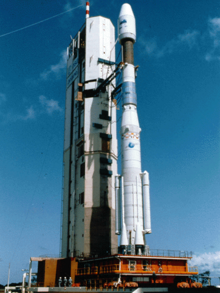Ariane 4

Ariane 4 was an expendable launch system, designed by the European Space Agency and manufactured and marketed by its subsidiary Arianespace.
The development program began in 1983 and the first successful launch was on 15 June 1988. The system has become the basis for European satellite launch with a stellar record of 104 successful missions and only three launch failures. Ariane 4 provided a payload increase from 1700 kg for Ariane 3 to a maximum of 4800 kg to geostationary transfer orbit (GTO). The record for Ariane 4 to GTO was 4946 kg.
The rocket was used in a number of variants - it could be fitted with two or four additional solid or liquid fuelled booster rockets. The launcher included a satellite payload carrier system called Spelda (Structure Porteuse Externe pour Lancements Doubles Ariane) for launching more than one satellite at a time.
Ariane 4 AR 40 was the basic version, with three stages: 58.4 m high, a diameter of 3.8 m, a liftoff mass of 245 t and a maximum payload of 2100 kg to GTO or 5000 kg to Low Earth orbit (LEO). Main power was from four Viking 5 motors each producing 667 kN of thrust; the second stage had a single Viking motor; and the third stage had an HM7 liquid oxygen/liquid hydrogen motor. AR 44L, with the maximum additional boost of four liquid fuel rocket strap-ons, was four-stage, weighed 470 t and could transfer a payload of 4730 kg to GTO or 7600 kg to LEO.
| Model | Launches | Successes | Failure date |
|---|---|---|---|
| AR 40 | |||
| AR 42L | |||
| AR 42P | 1 December 1994 | ||
| AR 44L | 22 February 1990 | ||
| AR 44LP | 24 January 1994 | ||
| AR 44P |
Ariane 4 has accomplished more than 100 flights with a success rate of more than 97%.
Ariane 4 was phased out in favour of Ariane 5, which can carry heavier payloads. The final launch was on 15 February, 2003, placing Intelsat 907 into geosynchronous orbit.
